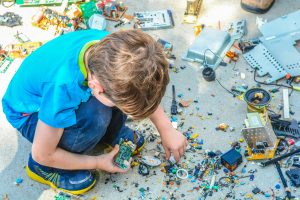What is one word that comes to mind when you think of libraries?
If you say books, I totally get it. Books, for the longest time have drawn individuals to the library and to librarianship, however, that association is starting to change. As the demands of society are constantly changing, so are the expectations of libraries. For so long, libraries have been known as institutions of learning, and that notion remains, but something more dynamic is making itself known about libraries. Libraries are “palaces of the people” and “for the people” (Stephens, 2022). They are redefining their role as “repositories of information” and have expanded it to include supporting, enriching ,and providing new experiences to the people (Pierce, 2021). This shift in thinking highlights that the true purpose of libraries is to “serve as a cornerstone of civic and social infrastructure that support strong communities” (Thomhave, 2023).

The Power of People
The keyword to this change is “people”. It is people that have transformed the library into a community hub, people have needs that go beyond books, and people need the space to be people. When libraries recognize that, they can transform into a space where people are prioritized, not books. Libraries encourage lifelong learning and to support that, they must recognize what the needs of the community are (Thomhave, 2023). Libraries can foster digital literacy supports, the introduction of innovative technologies, creativity, hands-on experimentation, and literacy (Rubio, 2019). With the efforts to cater to the diverse needs of the community, libraries are bringing in new ways to support community engagement and learning, allowing for both personal and professional groups for individuals of all ages.
To prioritize people, libraries must ensure that they are diverse, equitable, and inclusive. This means that libraries must understand and assess the needs of the neighbourhood, the individuals that come into the library, and services that they provide to help break down barriers present in society (O’Brien, 2019). By accommodating the diversity of community, libraries must include diverse collection materials and staff, disability accommodations, building infrastructure considerations for equal access and flexible spaces in their library policies and building constructions to ensure that the practices and services established can address those needs (Inclusive Solutions, n.d.). Programs and services can be specialized and created with children, seniors, individuals with disabilities, and all individuals regardless of “their sex, gender identity, race, religion and economic background” who want to use the library in mind (Inclusive Solutions, n.d.). This can include programs such as story times, drag queen story times, adult/senior programs, sensory programs, and that is just the start. Not only are there libraries that provide these services, but other libraries are bringing new resources, where people can check out interesting stuff such as “things, animals, seeds, or even people” (Everett, 2023). Libraries are bridging the gap for many issues and individuals, such as introducing early literacy at young ages, helping combat the summer slide, or even bridging the digital divide by offering support and tools to patrons to help them navigate these changes and provide access to materials that not all might have access to (Nicodemus, 2023). People have access to so many different resources and information can be shared to a greater extent. Therefore, when inclusivity and accessibility is integrated into the library, it expands to the people.

Embrace the Chaos
Dynamic and changing libraries have started to embrace something opposite of what the stereotypical library is known for… silence. Gone are the days where a scary librarian will tell you to “shush” if you are being too loud. Of course there are situations where the library has spaces for quiet study, but now libraries have become places where play is embraced, and creativity can thrive. Makerspaces have been making their way into libraries and it is allowing for new skills and personal connections to be developed. Children are being encouraged to play in the library and build the skills that get them ready for school, and encourage imagination, creativity and development (Creative Library Concepts, 2022). This emphasizes that libraries are no longer just a place where individuals can get book, its is a dynamic community hub, filled with opportunities where individuals can come together and be social and experience different cultures. It is a platform for individuals to gather, connect, collaborate, and share experiences. Through this, the library and the community are able to bond and foster a welcoming community.

Experience the Library on Your Terms
As you can see, libraries are changing, and they are constantly changing. They have definitely changed from the traditional quiet stuffy libraries that people stereotypically associate with (Liakos, 2024). Libraries are embracing their role as community hubs that foster and value culture and social interactions (Liakos, 2024). They encourage learning in new ways through developing skills alongside people in creative and collaborative ways. Libraries have put emphasis on access and information, making a space where all are welcome, and they can feel supported and see themselves represented in the space, services, programs, and materials (Mack, 2013). Libraries are for the people and they will continue to evolve and vital to community, so go to your local library and see what it has to offer and how it stays relevant in our constantly changing world.
References
Creative Library Concepts. (2022, August 25). The importance of play in children’s spaces (and how library furniture can encourage it). LinkedIn. https://www.linkedin.com/pulse/importance-play-childrens-spaces-how-library–
Everett, W. (2023, September 5). Alternative libraries: Check out things, not books. Insteading. https://insteading.com/blog/alternative-libraries/
Liakos, K. (2024, February 12). Evolving beyond books: The transformative role of public libraries into Community Buildings. The Gauntlet. https://thegauntlet.ca/2024/02/12/evolving-beyond-books-the-transformative-role-of-public-libraries-into-community-buildings/
Mack, C. (2021, December 17). Crowdsourced design: Why Los Angeles is asking the public to create the Library of the Future. Good. https://www.good.is/articles/crowdsourced-design-why-los-angeles-is-asking-the-public-to-create-the-library-of-the-future
Nicodemus, B. (2023, June 21). Beyond books, libraries are vital community hubs. Gensler. https://www.gensler.com/blog/beyond-books-libraries-are-vital-community-hubs
O’Brien, C. (2019, June 24). How San Francisco’s public libraries are embracing their changing role. Shareable. https://www.shareable.net/how-san-francisco-public-libraries-are-embracing-their-changing-role/
Pierce, D. (2021, June 21). 21st century libraries: Changing from the ground up. Library Journal. https://www.libraryjournal.com/story/2-st-century-lbraries-changing-from-the-ground-up-lj210616
Rubio, R. (2019, March 18). The evolution of the library. Canadian School Libraries Journal. https://journal.canadianschoollibraries.ca/the-evolution-of-the-library/
Stephens, M. (2022). Hyperlinked library master lectures 2022: The hyperlinked library participatory service & transparency [Course presentation]. School of Information, San Jose State University. https://sjsu-ischool.hosted.panopto.com/Panopto/Pages/Viewer.aspx?id=2a19a4b6-e945-4d2e-abf1-aef3014172a5
Thomhave, K. (2023, November 17). Not your mother’s library: How book-borrowing institutions are evolving. Smart Cities Dive. https://www.smartcitiesdive.com/news/city-public-libraries-changing-services-education/700069/
Hi Jemielyn!
I appreciate you mentioning DEI in public libraries! This is such a huge component of librarianship and I feel that several libraries in modern times are barely getting on track with DEI efforts. In my current position, I am part of the racial equity committee where we analyze the infrastructure and other aspects of the library through a DEI lens. It’s so much work and yet, so rewarding to see more representation.
Hi Michelle!
I definitely do agree. I think it is such an important part of the library. I always think about how it was growing up and never being able to fully relate to everyone, especially in books because I was never represented. Or another thing was those name keychains, I could never find my name on them, and I remember the impact it had on me as a child. If we can start it early in public libraries, I think it can help show how welcoming and inclusive the library can be.
I really enjoyed reading your post, and you are so right, libraries are so much more than books. I love that many libraries are “embracing the chaos” through makerspaces and fun community activities… but I do wish that more of them would join the fun. I help assistant teach freshman classes at my local university library, and I was pretty shocked to learn that many of them come from towns where their school and public libraries do not have makerspaces or community events/activities. Maybe they do, but the students are just unaware. In that case, those libraries need to reach out and connect more to their community and make their presence known.
Hi Millicent!
I do agree with people joining the fun. Lately, in my own library system, we have been getting lots of questions why the library is no longer quiet. I think especially when other patrons hear that it can dissuade them from interacting at times because I see them looking over trying to hear what I will say. But I think even when the “chaos” is happening, it’s important to still invite them, especially if it is a program with no registration. Just being able to expand it so that not the usual people attend is always important.
Jemielyn,
I appreciate your thoughtful post and perspective. The library system for which I work is encountering challenges in that we are performing more outreach but our current staff prefers the in-branch environment and interactions. We are looking to hire outreach staff who enjoy initiating public interactions, spreading awareness and attending off-site events. So we believe in the power of people but also having the right person in the right role is powerful. 🙂 Especially when we have very little turnover and high tenure in our staff. It is a good thing but we are looking to evolve.
Take care, Sara
Hi Sara! Thank you for mentioning staff. I think having the right staff is super important because being able to evolve really changes things. I have seen library branches where there are lot of turn over and branches with very little turn over, and both have their own impact in libraries evolving. I can’t really say which one I believe is good, but I think it makes a difference when the right people are placed in the right role because the library and the individuals are able to thrive. We can have a library, but having the employees and the people transform the library from just a building to a community hub.